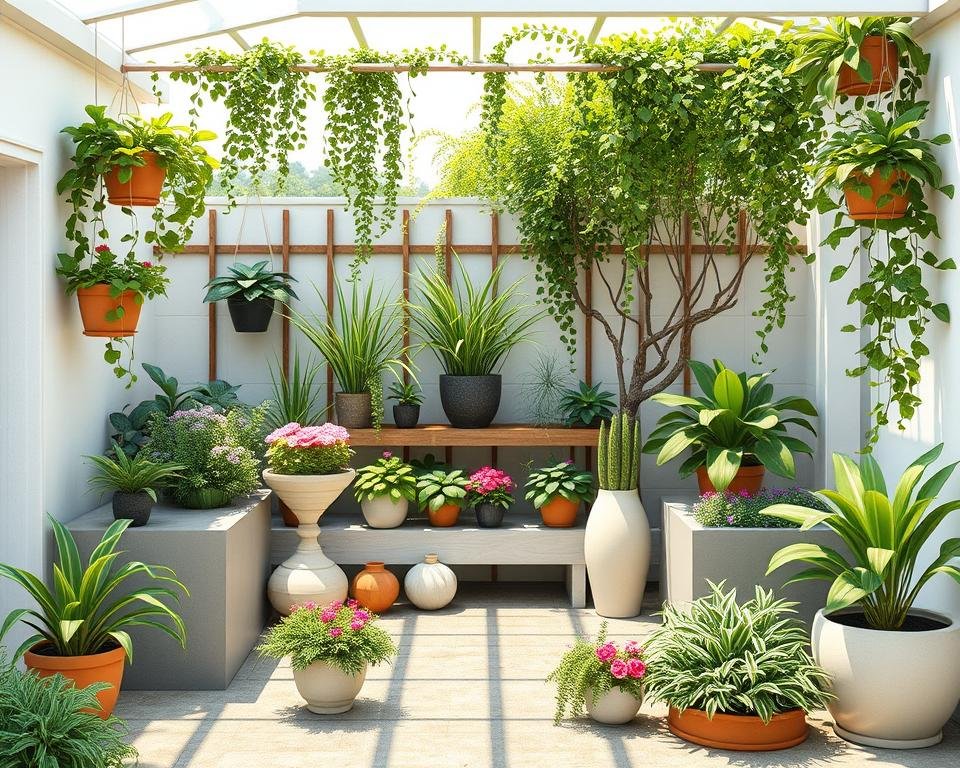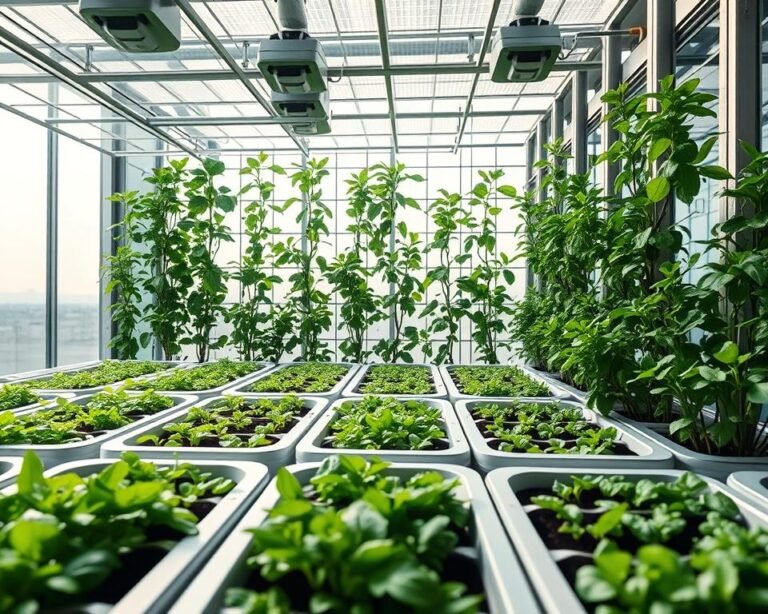Garden Layout Planning For Container Garden
I remember my first time turning a bare patio into a colorful container garden. It was exciting to create a living space full of colors and textures. I quickly realized that garden layout planning is more than just placing plants, it’s about designing a personal outdoor space that reflects your style and love for gardening.
Designing a garden needs careful thought. How you plan your containers will make or break your garden. Every pot and plant choice plays a role in garden layout planning and helps create a space that’s both beautiful and functional.d thriving garden that fits your space.
Container gardens are great for city folks, balcony gardeners, and those with little outdoor space. With the right design and smart garden layout planning, even a small area can become a thriving green oasis. It’s all about using your space wisely.
Key Takeaways
- Container gardens provide versatile solutions for limited spaces
- Strategic layout planning is crucial for garden success
- Consider sunlight, container size, and plant compatibility
- Creativity and personal style drive effective garden design
- Proper planning leads to a thriving, beautiful outdoor space
Essential Container Garden Planning Fundamentals
Starting a container garden needs careful planning and organization. It’s about turning small spaces into lively green spots. Understanding the basics is key.
When you map out your garden, think about a few important things. Each choice affects your garden’s health and how well it grows.
Assessing Your Space and Sun Exposure
Knowing how much space you have is vital for gardening in containers. Plants need different amounts of sunlight:
- Full sun plants need 6-8 hours of direct sunlight daily
- Partial shade vegetables like lettuce thrive with 3-5 hours of sunlight
- Think about how the area around your garden affects the sun it gets
Understanding Container Size Requirements
Picking the right size container is important for your plants to grow well. Here’s a simple guide:
- 10-12″ pot: 3-4 plants
- 14-16″ pot: 5-7 plants
- 16-20″ pot: 6-9 plants
Choosing the Right Soil and Drainage
Choosing the right soil and making sure it drains well is crucial. Here’s what experts suggest:
- Fill containers two-thirds full with quality potting mix
- Make sure the soil level is a couple inches below the rim
- Use containers with multiple drainage holes
- Add slow-release fertilizers at the start of the growing season
Pro tip: Keep your garden watered well and place plants wisely to get the most out of it.
Garden Layout Planning: Design Principles and Strategies
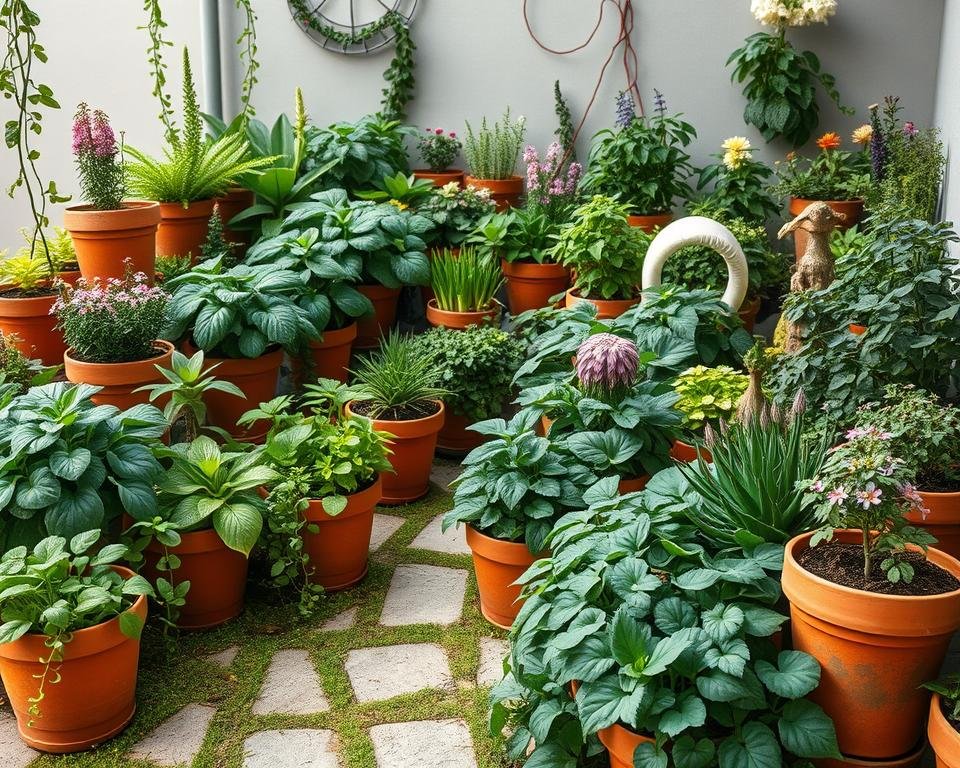
Creating a stunning container garden is more than just placing plants randomly. It needs thoughtful garden design to turn your outdoor space into a living art. When planning your planting bed arrangements, remember several key design principles. These principles will make your garden stand out.
Professional designers suggest a strategic approach to garden layout. They consider many factors:
- Visual balance and proportion
- Height and spatial relationships
- Color and texture interactions
- Environmental conditions
The Thriller, Filler, and Spiller formula is great for dynamic container plantings. It keeps your garden interesting all season. Thrillers are tall, eye-catching plants. Fillers add volume and cover the ground. Spillers cascade over edges, softening the design.
Research shows that 90% of successful garden layouts incorporate a mix of plant heights to create visual interest and privacy.
Your garden design should show your personal style but also be practical. About 75% of gardeners say their garden layout greatly affects their outdoor enjoyment. By choosing plants that complement each other and fit your environment, you can create a beautiful and useful garden. It will bring joy all year.
The Thriller-Filler-Spiller Formula for Dynamic Arrangements
Creating a stunning container garden is all about choosing the right plants. The Thriller-Filler-Spiller method makes your pots come alive. It adds drama and depth to your garden.
Imagine your container garden as a living artwork with three layers. Each plant has a special role. Together, they create a stunning view that grabs your attention.
Selecting Dramatic Centerpiece Plants
Your thriller plants are the stars of the show. They stand tall and grab your eye. Think about using:
- Ornamental grasses
- Tall coleus varieties
- Canna lilies
- Cordyline
Complementary Middle Layer Plants
Filler plants fill in the gaps and add depth. They create a lush look. Good choices include:
- Petunias
- Begonias
- Calibrachoa
- Coleus with bushy growth
Cascading Elements for Edge Appeal
Spiller plants make your container look full and lush. They spill over the edges, adding beauty. Try using:
- Sweet potato vine
- Trailing nasturtiums
- Ivy
- Creeping jenny
Experts suggest using container gardening techniques. They help balance color, texture, and growth for the best look.
Container Selection and Placement Techniques
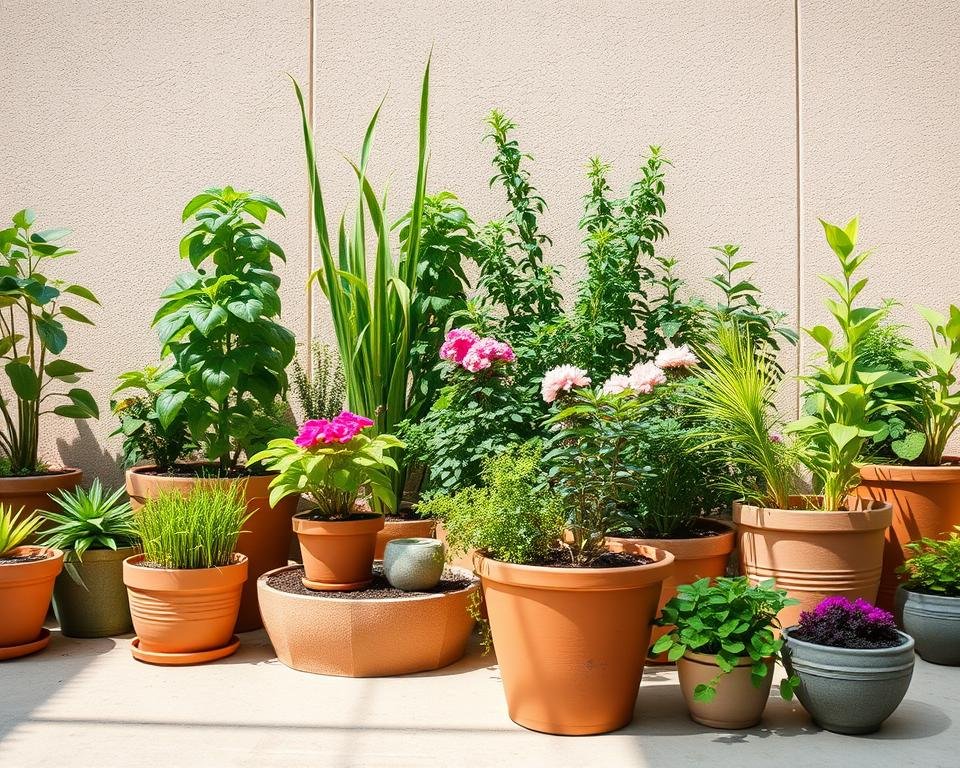
Choosing the right containers is key for a successful container garden. It affects both looks and plant health. The right placement can turn your outdoor area into a lively, useful space.
When picking containers, think about these important points:
- Material durability for outdoor conditions
- Size appropriate for specific plant needs
- Style that complements your hardscaping integration
- Weight and stability in various weather conditions
Container placement is crucial for hardscaping integration. Large rectangular containers work best at the back of groupings. Shorter containers add depth in the front. Round vessels look great with taller planters in the center.
To zone your garden well, group containers by water needs. This makes care easier and helps plants thrive. Here are some placement tips:
- Place containers near water sources
- Create visual barriers using tall plants
- Use elevated planters for dramatic height variations
- Incorporate weather-resistant materials
Experts suggest choosing two to three large statement plants over many small ones. This makes your garden more interesting and easier to care for.
Plant Selection Based on Design Styles
Creating a beautiful container garden is more than picking plants. It’s about showing off your style through your garden design. Choosing the right plants is key to making your space look amazing.
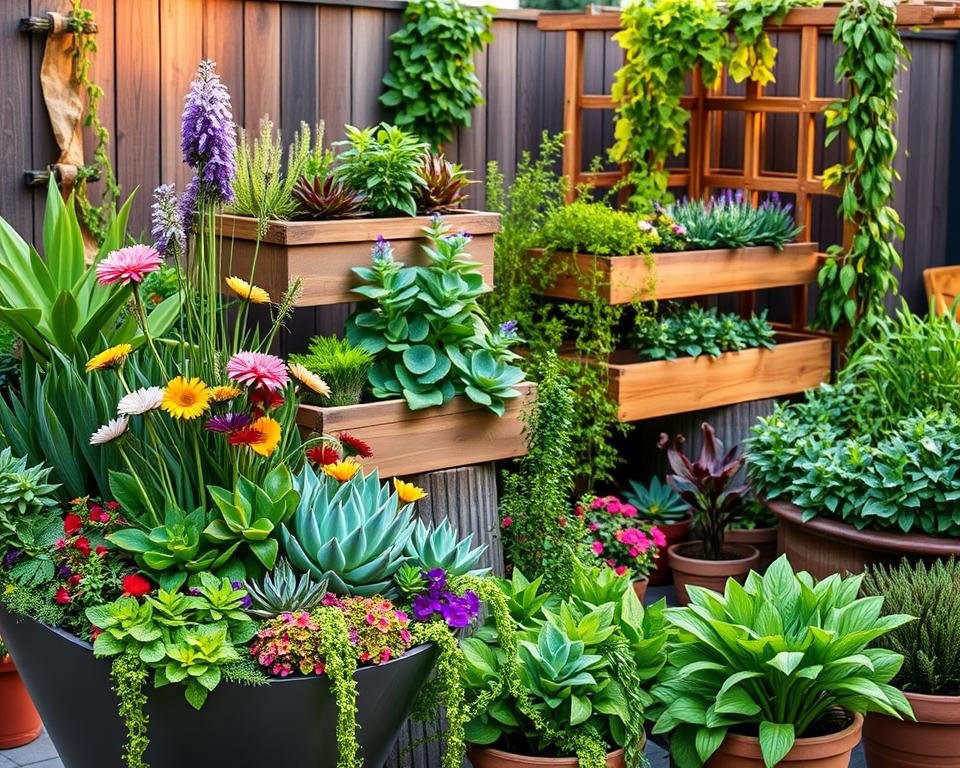
Knowing how design styles affect plant choices can make your garden stand out. Experts say each style needs its own way of picking plants.
Modern and Minimalist Combinations
Modern gardens are all about clean lines and big statements. Your minimalist garden should have:
- Architectural plants with striking silhouettes
- Monochromatic color schemes
- Plants with dramatic textures and shapes
For modern designs, consider these plants:
| Plant Type | Characteristic | Visual Impact |
|---|---|---|
| Succulents | Geometric forms | High contrast |
| Ornamental Grasses | Linear structure | Movement and texture |
| Snake Plants | Vertical lines | Sculptural presence |
Traditional Garden Arrangements
Traditional gardens love symmetry and classic looks. Your strategy should focus on:
- Balanced plant groupings
- Symmetrical container placement
- Classic color combinations
“In traditional garden design, harmony and proportion are paramount.” – Landscape Design Expert
Tropical and Exotic Layouts
Tropical gardens are all about bright colors and lush textures. Plant selection strategies for these designs should include:
- Bold, large-leafed plants
- Bright, saturated color palettes
- Layered plant heights
By understanding these design styles, you can make container gardens that show off your unique taste while following professional design rules.
Maintenance and Care Considerations
Creating a successful garden starts with careful planning and organization. Your container garden needs regular care to flourish. Since container plants grow differently, they need extra attention.
Watering is key for your container garden. In hot weather, plants might need water every day. Here are some important care tips:
- Check soil moisture daily, even in sunlight
- Use drip irrigation or soaker hoses for steady watering
- Water deeply to help roots grow strong
- Change how often you water based on the plant and weather
Fertilizing is also vital for your garden’s health. Containers lack nutrients, so regular feeding is needed. Use a balanced, water-soluble fertilizer every two weeks when plants are growing.
Keeping pests away is important. Check your garden weekly for pests, diseases, or nutrient issues. Remove dead or yellow leaves to keep plants healthy.
Pruning and deadheading keep your garden looking good and plants healthy. Cut off spent blooms to encourage more flowers and save energy.
Remember: A well-maintained container garden shows your dedication and care.
By following these care tips, you’ll have a lively, thriving container garden. It will bring joy all season long.
Seasonal Planning and Plant Rotation Strategies
Your container garden needs smart seasonal planning. Container gardens are great for changing up your garden all year. Knowing when to switch plants keeps your garden looking fresh.
Rotating plants helps keep the soil healthy and fights pests. Swap out plants every season to keep things interesting. Cool-season crops like lettuce can be replaced with warm-season plants like tomatoes.
Keep track of your plants in a garden journal. Get rid of any sick plants to stop pests. Use plants like beans to add nutrients back to the soil. A well-planned garden stays beautiful all year and stays healthy.
Spring to Summer Transitions
Spring is the perfect time to update your garden. Start with cool-season plants and add warm-season ones as it gets warmer. Choose plants that grow well together and need the same nutrients.
Fall and Winter Preparations
Get your containers ready for cooler weather by adding cover crops like winter rye. These plants keep the soil in place and make it richer. Pick hardy plants that can handle the cold to keep your garden looking good even when it’s not growing.
Year-Round Interest Planning
Make your container garden interesting all year. Mix in perennials and annuals, add ornamental grasses, and play with textures and colors. With the right planning, your garden will be a highlight all year.

